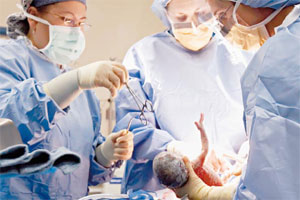Thirty-eight weeks after gestation, the fetus is already capable of exiting towards the exterior. Its organs have a noticeable maturity, reason for which birth is imminent. When the mother feels recurring contractions and the amniotic bag in which the baby has been for all nine months breaks, one of the most important (and final) processes of gestation begins: childbirth. During this process, the fetus manages to reach the exterior, along with all of the attached structures that accompanied it during development.
Childbirth is preceded by a series of phenomena that reveal their imminence. The fetus descends through the superior opening of the maternal pelvis and positions its head in the inferior part of the osseous structure, resting against the cervix, project call fitting.
Continuous uterine contractions appear as well; although they become common during the last few months, they intensify the days preceding birth. Another one of the clear signs is the exiting, through the vaginal orifice, of a mucous, yellowish mass. It is the mucous plug of the cervix; this way, one of the stretches through which the fetus will be expulsed is cleared.
Decisive stage
Childbirth is considered a team job, which involves the mother as well as the child about to be born. It has three, clearly different stages: dilation, expulsion and afterbirth. During the first stage, the cervix dilates considerably (nearly 10 centimeters). It is a process that can last hours, depending on each woman. Generally, it is shorter in women that have already had children.Once the passage is open, the baby can go through the cervix and vagina. It is not an easy move because it must go through a series of movements that benefit its quick expulsion. As the baby’s body advances, it must twist and its head shifts according to the diameter with the widest opening. At the end of this second stage, the fetus is capable of shyly peeking through the mother’s vulva. It is the moment the head comes out, followed by the shoulders and the rest of the body. Although the expulsion stage can last up to ninety minutes, the moment that goes from the appearance of the head to the exiting of the body only lasts a few seconds. Afterbirth is the final part of childbirth. Here, all the membranes that accompanied the child during gestation are discarded. This happens thanks to the fact that the uterine contractions continue, managing to expulse the placenta, part of the cord and other tissues that covered the fetus.








